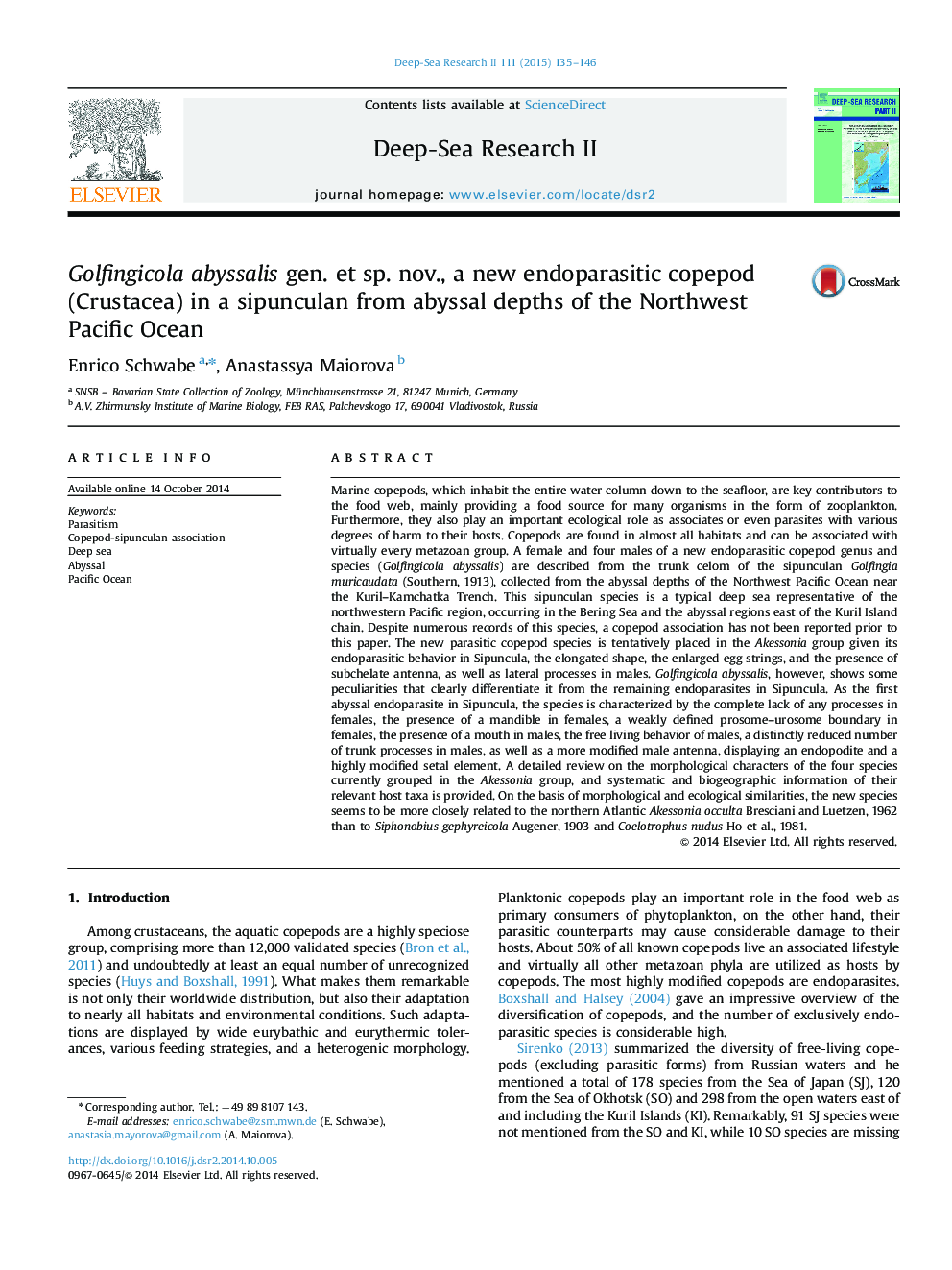| کد مقاله | کد نشریه | سال انتشار | مقاله انگلیسی | نسخه تمام متن |
|---|---|---|---|---|
| 4536286 | 1626429 | 2015 | 12 صفحه PDF | دانلود رایگان |
عنوان انگلیسی مقاله ISI
Golfingicola abyssalis gen. et sp. nov., a new endoparasitic copepod (Crustacea) in a sipunculan from abyssal depths of the Northwest Pacific Ocean
دانلود مقاله + سفارش ترجمه
دانلود مقاله ISI انگلیسی
رایگان برای ایرانیان
موضوعات مرتبط
مهندسی و علوم پایه
علوم زمین و سیارات
زمین شناسی
پیش نمایش صفحه اول مقاله

چکیده انگلیسی
Marine copepods, which inhabit the entire water column down to the seafloor, are key contributors to the food web, mainly providing a food source for many organisms in the form of zooplankton. Furthermore, they also play an important ecological role as associates or even parasites with various degrees of harm to their hosts. Copepods are found in almost all habitats and can be associated with virtually every metazoan group. A female and four males of a new endoparasitic copepod genus and species (Golfingicola abyssalis) are described from the trunk celom of the sipunculan Golfingia muricaudata (Southern, 1913), collected from the abyssal depths of the Northwest Pacific Ocean near the Kuril-Kamchatka Trench. This sipunculan species is a typical deep sea representative of the northwestern Pacific region, occurring in the Bering Sea and the abyssal regions east of the Kuril Island chain. Despite numerous records of this species, a copepod association has not been reported prior to this paper. The new parasitic copepod species is tentatively placed in the Akessonia group given its endoparasitic behavior in Sipuncula, the elongated shape, the enlarged egg strings, and the presence of subchelate antenna, as well as lateral processes in males. Golfingicola abyssalis, however, shows some peculiarities that clearly differentiate it from the remaining endoparasites in Sipuncula. As the first abyssal endoparasite in Sipuncula, the species is characterized by the complete lack of any processes in females, the presence of a mandible in females, a weakly defined prosome-urosome boundary in females, the presence of a mouth in males, the free living behavior of males, a distinctly reduced number of trunk processes in males, as well as a more modified male antenna, displaying an endopodite and a highly modified setal element. A detailed review on the morphological characters of the four species currently grouped in the Akessonia group, and systematic and biogeographic information of their relevant host taxa is provided. On the basis of morphological and ecological similarities, the new species seems to be more closely related to the northern Atlantic Akessonia occulta Bresciani and Luetzen, 1962 than to Siphonobius gephyreicola Augener, 1903 and Coelotrophus nudus Ho et al., 1981.
ناشر
Database: Elsevier - ScienceDirect (ساینس دایرکت)
Journal: Deep Sea Research Part II: Topical Studies in Oceanography - Volume 111, January 2015, Pages 135-146
Journal: Deep Sea Research Part II: Topical Studies in Oceanography - Volume 111, January 2015, Pages 135-146
نویسندگان
Enrico Schwabe, Anastassya Maiorova,